Kayak Fly Fishing
The Chesapeake Bay and its tributaries offer many opportunities for fly fishing. Add a kayak and you have a very effective fish-catching combination. This section of Kayak Fishing 101 provides basic information about fly fishing from a kayak in the Chesapeake.
A Casting Myth
Let's dispel one myth immediately. You do not need to launch 100 foot casts to catch fish. Casts of 50 feet or less are fine. There are good reasons for shorter casts.
- Casting a fly rod from a sitting position naturally reduces distance somewhat.
- A kayak allows you to get close to structure and the fish. You don't need to cast far to reach them.
- Hook-ups are easier with shorter casts. Wind and waves are going to put slack in your fly line. The less line in the water the less slack and the more hook-ups you'll have.
Equipment
In many ways fly fishing is a simpler process than fishing with conventional tackle. The reel is mainly a device to hold the line. You manipulate the line in most situations by hand, not by the reel. The rod is a long lever that propels the line (and the fly) to its target. And while there are many kinds of flies you'll find that only two types are required to catch most of your quarry in the Chesapeake. You need no swivels or weights or other terminal tackle. A leader and tippet which you can construct from regular monofilament will serve that purpose. You will need to address storage of your fly rod in the kayak because conventional kayak rod holders will not work. But there are ready solutions for that.
Rods
Fly rods are classified by their "weight" which is a number assigned to them based on the weight of the line they are designed to throw. Those numbers range from 0 to 14. The higher the number the stronger the rod and the more it will physically weigh in your hand. A 4-weight fly rod is a wispy tool for tossing tiny flies to trout in a stream but it would have little application in the Chesapeake. Rods 6 to 9 weight would be better choices for kayakers chasing white perch, croakers, blues, speckled trout, redfish and stripers. The best all-around rod is an 8 or 9 weight. That rod will have enough muscle to toss a heavy fly or popper and yet not overpower an 11 inch white perch.
Fly rods range in length from 7 to 9 feet. For kayak fishing an 8.5 to 9 foot rod is ideal. The extra length is helpful when casting from a seated position. When you are seated there is less distance from the top of your rod to the water. Hitting the water with your back cast will ruin your cast but extra rod length will minimize that occurrence.
Lastly, and paradoxically, a heavier weight rod may actually be less tiring to use than a lighter weight rod during a long day of fishing. That's because the heavier rod will throw weighted flies and larger wind resistant flies needed on most Chesapeake outings with less physical effort than would be required on a lighter rod.
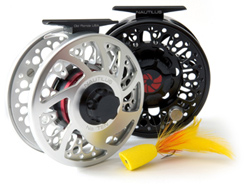
Reels
Fly reels hold the fly line and backing (100 yards or so of 20 to 30 pound test line for fish that run.) They have interchangeable spools and most have adjustable drags. For the majority of Chesapeake fly fishing kayakers an inexpensive reel will suffice. It's rare that you will "put a fish on the reel." That means to actually crank in the fish with the reel. You will catch most fish recovering the line by hand. So the reel is basically a line holder, not a line retrieval mechanism.
Lines
The most important thing about lines is that they be matched to your rod. You would be hard-pressed to cast a 9 weight line on a 6 weight rod. The line will be too dense for the rod and you will have trouble shooting it forward. Casting mismatched line on a rod will frustrate you and probably ruin your casting stroke. The line should always be rated for your rod – an 8 weight line on an 8 weight rod, for example.
There many kinds of fly lines but two, floating and sinking, are best for Chesapeake kayakers.
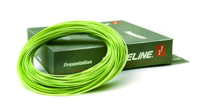
Floating Line
The easiest line to cast is floating line with a weight forward taper. Weight forward means it is heavier at the front portion of the line. Floating means it floats on the surface of the water for the entire length of the line.
Since these lines float, they are impractical for deep water fishing. The fly will sink only as far as the monofilament leader allows. But even using a 9 foot leader doesn't mean that the fly will sink to 9 feet. As the fly is retrieved it will rise toward the surface following the floating line. So at best it will run a few feet below the surface, sinking only during pauses in the retrieve. Nevertheless, that action (up and down while moving forward) is a great fish attractant in shallow water and near structure. Floating lines are therefore perfect for those applications.
Sinking line
Sinking lines take the fly down below the surface. It is sold by its weight in grains (i.e. 200, 250, etc.) and these grains equate to various fly rod weights. Sinking lines are also rated by how fast they sink in inches per second. These rates may vary from 1 to 8 inches per second.
Fly fishing with sinking lines is very different than floating lines. You are more likely to use them in deeper water of course, but the main difference is that casting them is unlike casting floating lines. They are heavier than floating lines and react accordingly on your rod. With sinking line you can make only one thrust forward with your rod to shoot the line. If done properly, the line will travel far. But it takes practice to handle their extra weight.
Leaders and Tippets
The fly rodding equivalent of terminal tackle is the leader and tippet. A leader is a 6 to 10 foot-long piece of monofilament that attaches to the fly line usually by a loop to loop connection. A tippet is the final increment of monofilament on the leader. It is a couple of feet long and of thinner diameter monofilament than the leader. The fly is tied to the tippet.
On floating line, a tapered bass fly leader and tippet combined to be 9 feet long will suffice. They're heavy at the butt and taper to about a 10 pound test tippet. The stout butt and taper help the fly to turn over nicely at the end of the cast instead of collapsing on the water and scaring fish in the shallows. Tippets get shorter with every fly change as you cut them back. To restore their length add a piece of 10 pound monofilament to the leader via a surgeon's knot.
On sinking line, a 6 foot length of 12 to 15 pound monofilament will serve nicely as a leader and tippet. There is no need to worry about subtlety when using sinking line. It is inevitably going to slap the water but the fish are far enough beneath it to cause them no concern. As on floating line, attach the monofilament to the sinking line with a loop to loop connection.
Flies
Chesapeake fish respond nicely to streamers and surface flies. Two proven forms of those flies are discussed below:
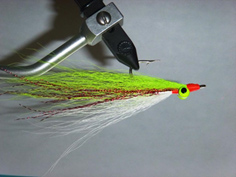
The Clouser Deep Minnow
The Clouser Deep Minnow is a streamer (sub-surface) fly. It is the fly rod version of the bucktail jig, perhaps the most prolific fish-catching lure of all time. The Clouser has earned a similar reputation in fly fishing circles by catching everything from rainbow trout to bluefish. Any fish that preys on other fish will bite it.
It has lead eyes which cause it to sink and it is usually tied with two contrasting colors of bucktail. Most patterns have white bucktail on the bottom to simulate the light colored bellies of fish.
The Clouser rides through the water with the hook up, thereby giving it a snag-free property. When retrieved with a stop and start motion the bucktail pulsates as the fly dives and rises adding to its allure.
It's an easy fly to tie and can be made in a variety of hook sizes to match the size of baitfish. Size 6 and size 4 hooks are appropriate to target white perch. A Clouser on a 2/0 hook will attract stripers, bluefish or speckled trout.
Clouser Techniques
Clouser Minnows can be fished on floating or sinking lines. With floating line target the shoreline, casting to riprap, dock pilings or downed wood. Cast to a particular target area, retrieve it for four or five feet and then lift the entire line out of the water and shoot it to the next target spot. That allows you to cover a particular shoreline much faster than with conventional tackle because you do not have to reel a lure all the way back to the kayak before casting it again to a new spot.
When fishing a Clouser on sinking line, cast the fly to deeper water and allow the line to sink it to the desired depth. Retrieve it by pulling the line back slowly by hand until almost all the line is recovered. Then shoot it out with only one backcast and start the process again. (False casting sinking line is almost impossible. It's far too heavy to keep in the air for false casts. One simple well-timed wave of the rod backward and forward is that is needed to get the line out.)
Foam Poppers
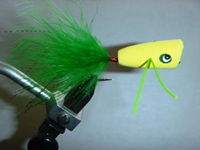
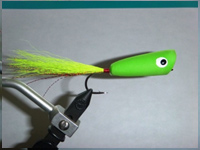
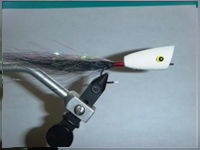
The fly rod equivalent to a conventional plug is a "popper" cast on floating line. Catching a striper on the surface is great fun. Catching them on a fly rod on the surface is the ultimate fishing thrill.
Poppers made from foam are a practical and simple option for Chesapeake fly fishing kayakers. They're colorful and stand up to the rigors of multiple strikes. Their tails can be feathers or hair or a combination of both. Their sizes range from size 4 hooks to size 3/0 hooks with corresponding foam bodies from 2 to 4 inches in length. Foam poppers can be purchased on-line or in fly shops or inexpensively made with readily available component parts. In short they are the ideal top water alternative for fly fishermen.
Popper Techniques
Poppers are used on floating line. They are lighter than Clouser Minnows but they pose a slightly different problem when casting due to the aerodynamics of their large cupped face. Depending on their size, they can be like little parachutes with significant wind resistance. However, an 8 or 9 weight rod has the power to handle them.
Casting poppers to breaking stripers is the easiest way to employ them. Hook-ups come fast and furious. In fact you hardly have to move the popper in such circumstances. As soon as it hits the surface a hungry striper will swipe at it.
It is more challenging when no surface activity is evident. In those cases laying a popper next to a sod bank or rip rap and pulling the line so that the popper chugs forward is a good approach. The key is to keep it moving after the first hit. Stripers often slap at poppers with their tails and then come back to swallow them. It's important to keep them moving after the initial attack. That gives the appearance that the popper is a living creature trying to escape and it heightens the striper's attack instincts. Also, keep the rod tip low and close to the water while popper fishing. When the striper strikes and you feel its weight on the line, lift the rod tip to set the hook and start pulling line in with your other hand.
Popper fishing is best done during low light conditions. Early mornings and during dusk often provide the best opportunities.
To conclude the discussion about the flies, you do not need to carry many varieties. Clouser Minnows and Foam Poppers will give you plenty of action. You may want to vary colors. But otherwise keep your fly selections simple.
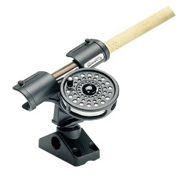
Rod Storage
Because of their configuration fly rods are not compatible with most kayak rod holders. They cannot slide into to the common "Rocket Launcher" holder nor will they fit in a Scotty or Ram rod holder designed for spinning and bait cast rods. Fortunately Scotty and Ram have addressed this and both companies make fly rod-specific holders that fit into their normal rod mounts. Also some kayaks provide for horizontal storage of fly rods along their gunnels.
Casting and Fly Line Management
In most kayaks you will cast while sitting. There are things you can do to make that process easier.
- Make sure your rod is properly balanced with the right sized line and let the rod load with the weight of the line on the back cast. The fly casting motion has been described in many ways. Some suggest keeping your rod within the 10:00 a.m. to 2:00 p.m. clock face arc. There is also the analogy of splattering paint from a paint brush. You bring the brush forward and suddenly stop causing the paint (the line) to fly from the brush. You can also aim your fly at the trees on the shoreline to keep your rod tip from dipping. The point in these visual aids is to make sure your release point is high. If you drop the rod tip on the forward or backward motion you will lose the power of the rod.
- Because you are sitting you may occasionally slap the water behind your kayak with your back cast. That will reduce line speed and not allow your rod to load to its fullest potential. Avoid this by consciously flipping the line high on the back cast. Think of this lifting motion like flipping pancakes with a spatula.
- The nature of fly fishing is that while actively fishing your line spends more time off of the reel than on it. That's not a problem if you're standing in a river, the shore or on a large boat. You simply drop the line to your feet or in a stripping basket. Your line flows out from there on casts and returns there when you retrieve it as your impart motion to your flies. However on a kayak finding room for your slack line can be a problem. Deck space is often small and paddles, pedals, rudder controls, tools, etc. will tangle with your line. Combat this problem as follows:
- Clear the deck. That allows you to drop the line between your legs on the deck without snagging anything.
- If you cast right-handed, clear the gunnel on the left side of the kayak – no paddle storage on the left; no electronics or rod holders on that side; no anchor trolley; nothing to stick up even slightly to obstruct the line. (Note: If you cast right-handed you will throw the line most of the time to the left side of the kayak. As you retrieve the line with your left hand, that side of the kayak needs to be free of obstructions.)
- If you cannot fit all of the line you retrieve on the deck drop it into the water on the left side of the kayak. The floating line will follow your drift in the kayak. Sinking line will occasionally go under the boat but usually that is no problem.
 Follow us
Follow us








